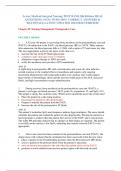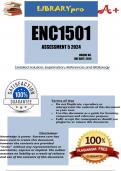Lewis: Medical-Surgical Nursing TEST BANK 8th Edition. REAL
QUESTIONS (NGN) WITH 100% CORRECT ANSWERS &
RATIONALE.LATEST UPDATED 2023/2024(VERIFIED)
Chapter 20: Nursing Management: Postoperative Care
MULTIPLE CHOICE
1. A 42-year-old patient is recovering from anesthesia in the postanesthesia care unit
(PACU). On admission to the PACU, the blood pressure (BP) is 124/70. Thirty minutes
after admission, the blood pressure falls to 112/60, with a pulse of 72 and warm, dry skin.
The most appropriate action by the nurse at this time is to
a. increase the rate of the IV fluid replacement.
b. continue to take vital signs every 15 minutes.
c. administer oxygen therapy at 100% per mask.
d. notify the anesthesia care provider (ACP) immediately.
ANS: B
A slight drop in postoperative BP with a normal pulse and warm, dry skin indicates
normal response to the residual effects of anesthesia and requires only ongoing
monitoring. Hypotension with tachycardia and/or cool, clammy skin would suggest
hypovolemic or hemorrhagic shock and the need for notification of the ACP, increased
fluids, and high-concentration oxygen administration.
2. During recovery from anesthesia in the postanesthesia care unit (PACU), a
patient’s vital signs are blood pressure 118/72, pulse 76, respirations 12, and SpO2 91%.
The patient is sleepy but awakens easily. Which action should the nurse take at this time?
a. Place the patient in a side-lying position.
b. Encourage the patient to take deep breaths.
c. Prepare to transfer the patient from the PACU.
d. Increase the rate of the postoperative IV fluids.
ANS: B
The patient’s borderline SpO2 and sleepiness indicate hypoventilation. The nurse should
stimulate the patient and remind the patient to take deep breaths. Placing the patient in a
lateral position is needed when the patient first arrives in the PACU and is unconscious.
The stable BP and pulse indicate that no changes in fluid intake are required. The patient
is not fully awake and has a low SpO2, indicating that transfer from the PACU is not
appropriate.
3. After a new nurse has been oriented to the postanesthesia care unit (PACU), the
charge nurse will evaluate that the orientation has been successful when the new nurse
a. places a patient in the Trendelenburg position when the blood pressure (BP) drops.
b. assists a patient to the prone position when the patient is nauseated.
c. turns an unconscious patient to the side when the patient arrives in the PACU.
d. positions a newly admitted unconscious patient supine with the head elevated.
,ANS: C
The patient should initially be positioned in the lateral “recovery” position to keep the
airway open and avoid aspiration. The prone position is not usually used and would make
it difficult to assess the patient’s respiratory effort and cardiovascular status. The
Trendelenburg position is avoided because it increases the work of breathing. The patient
is placed supine with the head elevated after regaining consciousness.
4. A 75-year-old is to be discharged from the ambulatory surgical unit following left
eye surgery. The patient tells the nurse, “I do not know if I can take care of myself with
this patch over my eye.” The most appropriate nursing action is to
a. refer the patient for home health care services.
b. discuss the specific concerns regarding self-care.
c. give the patient written instructions regarding care.
d. assess the patient’s support system for care at home.
ANS: B
The nurse’s initial action should be to assess exactly the patient’s concerns about self-
care. Referral to home health care and assessment of the patient’s support system may be
appropriate actions but will be based on further assessment of the patient’s concerns.
Written instructions should be given to the patient, but these are unlikely to address the
patient’s stated concern about self-care.
5. After removal of the nasogastric (NG) tube on the second postoperative day, the
patient is placed on a clear liquid diet. Four hours later, the patient complains of sharp,
cramping gas pains. Which action should the nurse take?
a. Reinsert the NG tube.
b. Give the PRN IV opioid.
c. Assist the patient to ambulate.
d. Place the patient on NPO status.
ANS: C
Ambulation encourages peristalsis and the passing of flatus, which will relieve the
patient’s discomfort. If distention persists, the patient may need to be placed on NPO
status, but usually this is not necessary. Morphine administration will further decrease
intestinal motility. Gas pains are usually caused by trapping of flatus in the colon, and
reinsertion of the NG tube will not relieve the pains.
6. Following gallbladder surgery, a patient’s T-tube is draining dark green fluid.
Which action should the nurse take?
a. Place the patient on bed rest.
b. Notify the patient’s surgeon.
c. Document the color and amount of drainage.
d. Irrigate the T-tube with sterile normal saline.
ANS: C
,A T-tube normally drains dark green to bright yellow drainage, so no action other than to
document the amount and color of the drainage is needed. The other actions are not
necessary.
7. In intervening to promote ambulation, coughing, deep breathing, and turning by a
postoperative patient on the first postoperative day, which action by the nurse is most
helpful?
a. Discuss the complications of immobility and poor cough effort.
b. Teach the patient the purpose of respiratory care and ambulation.
c. Administer ordered analgesic medications before these activities.
d. Give the patient positive reinforcement for accomplishing these activities.
ANS: C
The most essential nursing action in encouraging these postoperative activities is
administration of adequate analgesia to allow the patient to accomplish the activities with
minimal pain. Even with motivation provided by proper teaching, positive reinforcement,
and concern about complications, patients will have difficulty if there is a great deal of
pain involved with these activities.
8. The nurse evaluates that the interventions for the nursing diagnosis of ineffective
airway clearance in a postoperative patient have been successful when the
a. patient drinks 2 to 3 L of fluid in 24 hours.
b. patient uses the spirometer 10 times every hour.
c. patient’s breath sounds are clear to auscultation.
d. patient’s temperature is less than 100.4° F orally.
ANS: C
One characteristic of ineffective airway clearance is the presence of adventitious breath
sounds such as rhonchi or wheezes, so clear breath sounds are an indication of resolution
of the problem. Spirometer use and increased fluid intake are interventions for ineffective
airway clearance but may not improve breath sounds in all patients. Elevated temperature
may occur with atelectasis, but a normal or near-normal temperature does not always
indicate resolution of respiratory problems.
9. A patient who has begun to awaken after 30 minutes in the postanesthesia care
unit (PACU) is restless and shouting at the nurse. The patient’s oxygen saturation is 99%,
and recent lab results are all normal. Which action by the nurse is most appropriate?
a. Insert an oral or nasal airway.
b. Notify the anesthesia care provider.
c. Orient the patient to time, place, and person.
d. Be sure that the patient’s IV lines are secure.
ANS: D
, Because the patient’s assessment indicates physiologic stability, the most likely cause of
the patient’s agitation is emergence delirium, which will resolve as the patient wakes up
more fully. The nurse should ensure patient safety through interventions such as raising
the bed rails and securing IV lines. Emergence delirium is common in patients recovering
from anesthesia, so there is no need to notify the ACP. Insertion of an airway is not
needed because the oxygen saturation is good. Orientation of the patient is needed but is
not likely to be effective until the effects of anesthesia have resolved more completely.
10. Which action should the postanesthesia care unit (PACU) nurse delegate to
nursing assistive personnel (NAP) who help with the transfer of a patient to the surgical
unit?
a. Help with the transfer of the patient onto a stretcher.
b. Give a verbal report to the surgical unit charge nurse.
c. Document the appearance of the patient’s incision in the chart.
d. Ensure that the receiving nurse understands the postoperative orders.
ANS: A
The scope of practice for nursing assistants includes repositioning and moving patients
under the supervision of an RN. Providing report to another RN, assessing and
documenting the wound appearance, and clarifying physician orders with another RN
require RN level education and scope of practice.
11. When a patient is transferred from the postanesthesia care unit (PACU) to the
clinical surgical unit, the first action by the nurse on the surgical unit should be to
a. assess the patient’s pain.
b. take the patient’s vital signs.
c. read the postoperative orders.
d. check the rate of the IV infusion.
ANS: B
Because the priority concerns after surgery are airway, breathing, and circulation, the
vital signs are assessed first. The other actions should take place after the vital signs are
obtained and compared with the vital signs before transfer.
12. An 83-year-old who had a surgical repair of a hip fracture 2 days previously has
restrictions on ambulation. Based on this information, the nurse identifies the priority
collaborative problem for the patient as
a. potential complication: hypovolemic shock.
b. potential complication: venous thromboembolism.
c. potential complication: fluid and electrolyte imbalance.
d. potential complication: impaired surgical wound healing.
ANS: B





